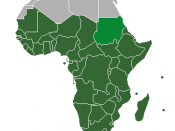In th early 80's, with the first knowledge of HIV spreading around the world, there were mass campaigns organized to stem the rate of further infection (Dossier 1989:56). Currently however, complacency with 'life'and how it is lived seems to dominate many mentalities in all corners of the world. Currently sub-Saharan Africa contains 29.4 million out of the 42 million individuals infected with the Human Immunodeficiency Virus (HIV) and Aquired Immunodeficiency Syndrome (AIDS). AIDS should be viewed as a three-front war: first, the classrooms of Africa, second the clinics of Africa and third, international action (anon2 2000:Internet). It is of course necessary to focus on treatment and medicine for those infected with the HIV, yet it is obvious that to lessen the burden on treatment facilities one essentially must focus on prevention of transmission. This requires governments and non-government organizations to put their energies into education and media programs, advocating safe sexual practices and publicly defying the stigmatization that accompany's HIV and AIDS.
The societywide shift from infectious diseases to chronic illnesses as the primary cause of death is called the "epidemiologic transition". (Eckert 1998:166). Sub-Saharan Africa has not fully experienced this transition.
Southern Africa is the worst hit region in the world by HIV/AIDS. Botswana has 35.8% of it's adult population infected. South Africa comes second with 19.9% infected with HIV. Zimbabwe life expectancy has dropped from 65 to 43 years as a direct result of HIV/AIDS. In Zambia one quarter of the city population is infected and one in seven people are infected in rural areas (Feachem 2003:Internet). In contrast to this these tragic statistics, in Uganda, there is now a real prospect of an almost AIDS-free generation of high-school-age children (anon2 2000:Internet). This is due to the intense effort of government and non-government organizations to push large-scale media...


